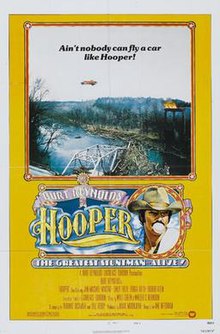
Burton Leon Reynolds Jr. was an American actor and considered a sex symbol and icon of 1970s American popular culture. Reynolds first rose to prominence when he starred in television series such as Gunsmoke (1962–1965), Hawk (1966), and Dan August (1970–1971). He had leading roles in films such as Navajo Joe (1966) and 100 Rifles (1969), and his breakthrough role was as Lewis Medlock in Deliverance (1972).
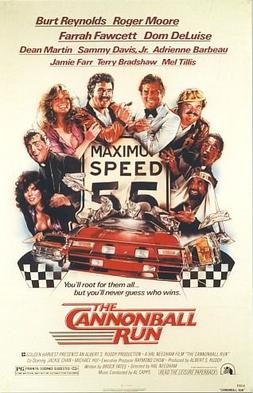
The Cannonball Run is a 1981 American action-comedy film directed by Hal Needham, produced by Hong Kong's Golden Harvest films, and distributed by 20th Century-Fox. Filmed in Panavision, it features an all-star ensemble cast, including Burt Reynolds, Dom DeLuise, Roger Moore, Farrah Fawcett, Jackie Chan, and Dean Martin. The film is based on the 1979 running of the Cannonball Baker Sea-to-Shining-Sea Memorial Trophy Dash, an actual cross-country outlaw road race beginning in Connecticut and ending in California.
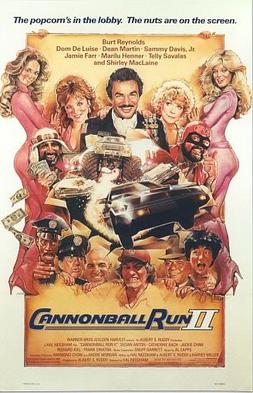
Cannonball Run II is a 1984 American action comedy film starring Burt Reynolds and an all-star cast, released by Warner Bros. and Golden Harvest. Like the original Cannonball Run, it is set around an illegal cross-country race.
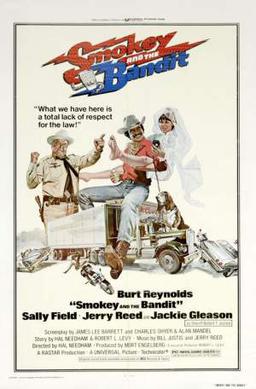
Smokey and the Bandit is a 1977 American action comedy film starring Burt Reynolds, Sally Field, Jackie Gleason, Jerry Reed, Pat McCormick, Paul Williams and Mike Henry. The film marks the directorial debut of stuntman Hal Needham.

Hal Brett Needham was an American stuntman, film director, actor, writer, and NASCAR team owner. He is best known for his frequent collaborations with actor Burt Reynolds, usually in films involving fast cars, such as Smokey and the Bandit (1977), Hooper (1978), The Cannonball Run (1981) and Stroker Ace (1983).
An outtake is a portion of a work that is removed in the editing process and not included in the work's final, publicly released version. In the digital era, significant outtakes have been appended to CD and DVD reissues of many albums and films as bonus tracks or features, in film often, but not always, for the sake of humor. In terms of photos, an outtake may also mean the ones which are not released in the original set of photos.

Smokey and the Bandit II is a 1980 American action comedy film directed by Hal Needham, and starring Burt Reynolds, Jackie Gleason, Jerry Reed, Dom DeLuise, Sally Field, Mike Henry, Paul Williams and Pat McCormick. The film is the second installment of the Smokey and the Bandit trilogy in the Smokey and the Bandit franchise and a sequel to Smokey and the Bandit (1977).

The End is a 1978 American black comedy film directed by and starring Burt Reynolds, written by Jerry Belson, and with music composed by Paul Williams. The film also stars Dom DeLuise along with Sally Field, Strother Martin, David Steinberg, Joanne Woodward, Norman Fell, Myrna Loy, Kristy McNichol, Pat O'Brien, Robby Benson and Carl Reiner.

Smokey and the Bandit Part 3 is a 1983 American action comedy film and a spinoff/legacy sequel to Smokey and the Bandit (1977) and Smokey and the Bandit II (1980). The film is the third and final installment of the Smokey and the Bandit trilogy in the Smokey and the Bandit franchise, starring Jackie Gleason, Jerry Reed, Paul Williams, Pat McCormick, Mike Henry and Colleen Camp. The film also includes a cameo near the end by the original Bandit, Burt Reynolds.

The Villain is a 1979 American metrocolor Western comedy film directed by Hal Needham and starring Kirk Douglas, Arnold Schwarzenegger, Ann-Margret, Paul Lynde, Foster Brooks, Strother Martin, Ruth Buzzi, Jack Elam, and Mel Tillis. It is a parody of Western films, blended with an homage to the Warner Bros. cartoon Wile E. Coyote and the Road Runner.
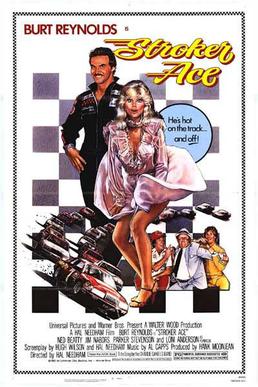
Stroker Ace is a 1983 American action comedy sport film directed by Hal Needham and starring Burt Reynolds as the eponymous Stroker Ace, a NASCAR driver.
Buddy Joe Hooker is an American actor, second unit director, stunt man, and stunt coordinator. He is known for his expertise in designing and performing vehicle stunts for movies and television.

Sharky's Machine is a 1981 American neo-noir action thriller film directed by Burt Reynolds, who stars in the title role. It is an adaptation of William Diehl's first novel Sharky's Machine (1978) with a screenplay by Gerald Di Pego. It also stars Vittorio Gassman, Brian Keith, Charles Durning, Earl Holliman, Bernie Casey, Henry Silva, Darryl Hickman, Richard Libertini, Rachel Ward and Joseph Mascolo.

Stan Barrett is a Hollywood stuntman, stunt coordinator actor, and former stock car racing driver. His biggest act was however outside the movie world. On December 17, 1979, he attempted to break the land speed record, and the sound barrier in the Budweiser Rocket rocket-powered three-wheel vehicle. His calculated speed was 739.666 miles per hour,, which would have made Barrett the first man to break the sound barrier in a land vehicle. The attempt was surrounded by controversy and the speed was never officially recorded. Barrett also raced in 19 Winston Cup Series races between 1980 and 1990, posting two top ten finishes.

Stunts, also released as The Deadly Game, is a 1977 American adventure thriller film set in the world of movie stunt performers directed by Mark L. Lester and starring Robert Forster, Fiona Lewis and Ray Sharkey. The first film produced by New Line Cinema, Stunts was part of a late 1970s/early 1980s cycle of stunt performer films that included stunt man-turned-director Hal Needham's Hooper (1978) and Richard Rush's The Stunt Man (1980).
Lada St. Edmund is an American personal trainer, dancer, singer, actress and stunt performer. St. Edmund became a popular nationally known go-go dancer on the 1965–1966 NBC-TV rock music series Hullabaloo. She later became the highest paid stuntwoman in Hollywood history.
Kenneth Marion Powers was an American stuntman. Powers was born to Edward Lee and Florence Pauline Powers in Landrum, South Carolina, on July 9, 1947. He grew up in Landrum, and after high school, he joined the U.S. Navy and served as a barber according to his DD 214. He died at the Hampton Veterans Center in Hampton, Virginia on February 28, 2009. He was married to Beverly Powers at the time of his death.

The Last Movie Star is a 2017 American comedy-drama film written and directed by Adam Rifkin, and starring Burt Reynolds, Ariel Winter, Clark Duke, Ellar Coltrane and Chevy Chase.
Bandit is a 1994 American made-for-television spin-off film series based on the Smokey and the Bandit franchise. The four telefilms – Bandit Goes Country, Bandit Bandit, Beauty and the Bandit and Bandit's Silver Angel – were produced for Universal Television's Action Pack programming block from original Smokey and the Bandit director/writer Hal Needham.
Smokey and the Bandit is an action comedy franchise following the exploits of bootleggers Bo "Bandit" Darville, Cledus "Snowman" Snow, and Texas county sheriff Buford T. Justice. The series consists of three theatrical films and four made-for-TV spinoff films.
